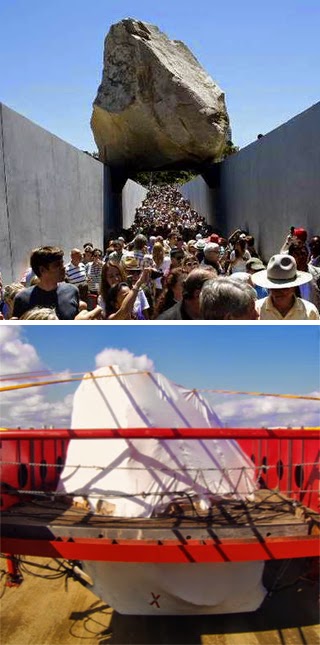by Drew Martin
It is not every day you come across an hour and a half long film about one sculpture so I recently relished watching Levitated Mass: The Story of Michael Heizer's Monolithic Sculpture.
Heizer received formal lessons at the San Francisco Art Institute in the early 1960's but the paintings he produced became more about sculpture and his sculptures became more about the world beyond the walls of galleries and museums. Heizer brought heavy construction to art with big earth-moving machines. A few of his pieces are about negative space, such as Double Negative, which he made in 1969 by carving out two swaths of sandstone rock about the size of the Empire State Building (on its side).
Levitated Mass is an enormous quarried rock that now sits on a trench outside of LACMA (Los Angeles County Museum of Art). The documentary is of course about the installed piece and Heizer's vision but the movie celebrates the engineering behind the logistics of transporting something so big and setting it in its place.
For much of the documentary we follow the moving crew as they hauled the rock with a specially designed rig, which was the size of a football field so that the load could be distributed over a large area; essential for when it was driven on overpasses.
The travel distance from the quarry to LACMA was more than 100 miles, and many of the crew walked along side the rock. The best part of the documentary were the candid interviews with the locals who came out to watch the procession. One man even used the occasion to propose to his girlfriend. And everyone had something different to say: from religious references and epiphanies to disbelief and suspicion. One woman even thought that it was military secret and offered that the form might just be styrofoam that encased some device.
What I liked learning the most about was that Heizer's father was an anthropological geologist, which means he was interested in stonecarving cultures, such as the Olmec, who had to move heavy blocks of stove over large distances.
skip to main |
skip to sidebar
The Museum of Peripheral Art
The Museum of Peripheral Art explores how we interact with and interpret art and media, in order to provide a unique experience, which the original might not convey.
The Museum of Peripheral Art is about serendipity, insight and contemplation.
- Drew Martin, Director
The Museum of Peripheral Art is about serendipity, insight and contemplation.
- Drew Martin, Director

